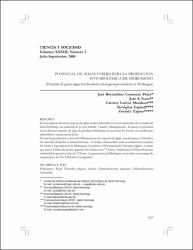| License | Creative Commons Atribución-NoComercial-CompartirIgual 4.0. | es |
| Author | Contreras Pérez, José Bernardino | |
| Author | Scott, José A. | |
| Author | Mendoza, Carmen Leticia | |
| Author | Espinal, Georgina | |
| Author | Zapata, Zoraida | |
| Accessioned date | 2023-11-21T23:11:03Z | |
| Available date | 2023-11-21T23:11:03Z | |
| Year | 2008 | |
| Citation | Contreras Pérez, J., Scott, J., Espinal, G., Mendoza Gómez, C., & Zapata, Z. (2008). Potencial de algas verdes para la producción fotobiológica de hidrógeno. Ciencia y sociedad, 33(3), 307-326. Recuperado de: | es |
| URI | https://bvearmb.do/handle/123456789/3663 | |
| Abstract | [Español] Se investigaron diversas especies de algas verdes obtenidas en las proximidades de la ciudad de Santo Domingo, en particular de los ríos Isabela, Ozama y Manoguayabo. Se ensayó el potencial de las diversas especies de algas de producir hidrógeno en ausencia de azufre, en condiciones anaeróbicas y en presencia de luz Se logró la producción exitosa de hidrógeno en tres especies de algas, una del género Chlorella y las otras dos del género Chlamydomonas. El tiempo transcurrido entre la evidencia de ausencia de azufre y la producción de hidrógeno fue inferior a 48 horas para la Chlorella vulgaris, en tanto que para la Chlamydomonas angustae fue inferior de las 72 horas y finalmente la Chlamydomonas reinhardtii lo generó al cabo de 72 horas. La generación de hidrogeno se produjo en un rango de temperatura de 25 a 32 grados centígrados. | es |
| Abstract | [English] Diverse species of green algae were investigated. They were obtained in the proximity of the city of Santo Domingo, particularly near the rivers Isabela, Ozama and Manoguayabo. The potential of the diverse species of algae to produce Hydrogen in absence of Sulfur, in anaerobe conditions and in the presence of light was examined. We achieved the successful production of Hydrogen in three species of algae, one of them from the genus Chlorella and the other two of the genus Chlamydomonas. The time elapsed between the Sulfur absence evidence and the production of Hydrogen was lower than 48 hours for the Chlorella vulgaris, while for the Chlamydomonas angustae was lower than 72 hours. Finally the Chlamydomonas reinhardtii generated it at the end of 72 hours. The generation of Hydrogen was produced in a rank of temperature from 25 to 32 degrees centigrade. | es |
| Language | Spanish | es |
| Published | Ciencia y sociedad, 33(3), 307-326 | es |
| Rights | © Ciencia y sociedad. | es |
| Rights URI | https://creativecommons.org/licenses/by-nc-sa/4.0/ | es |
| Subject | Recursos naturales - República Dominicana | es |
| Subject | Energías renovables | es |
| Title | Potencial de algas verdes para la producción fotobiológica de hidrógeno | es |
| dc.identifier.doi | https://doi.org/10.22206/cys.2008.v33i3.pp307-26 | |
| Material type | Article | es |
| Type of content | Scientific research | es |
| Access | Open | es |
| Audience | Technicians, professionals and scientists | es |


